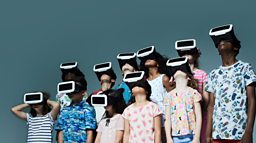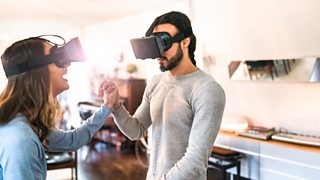Is there a dark side to VR and the metaverse?
From an elusive science fiction dream in the 1980s, to very real headsets in homes across the world today, virtual reality is making a genuine impact on our lives and social interactions.
For Βι¶ΉΤΌΕΔ Radio 4's All Consuming, presenters Amit Katwala and Charlotte Williams immerse themselves in the brave new worlds of virtual reality and the metaverse to find out where the innovative technology is leading, and explore VR's rapidly growing influence on art, entertainment and science.
They also take a look at the social connections forming inside the metaverse and ask, along with positive developments, what are the dangers? Is there a darker side to VR?
The term 'virtual reality' originates from 1938
The first utterances of the term 'virtual reality' appeared in The Theatre and Its Double by Antonin Artaud. The playwright described theatre as "la réalité virtuelle".
The term and concept grew in appreciation in the decades to follow. Consumer products, however, were largely commercial failures, that failed to break through to the mainstream.
Then in 2009, 16-year-old American high school student Palmer Luckey began building prototypes of what would eventually become the landmark Oculus Rift headset. Modern VR was born.
Virtual reality as we know it today is made up of a few components
Firstly, you need the VR headset, which includes in-built head tracking and a stereoscopic display, meaning a screen for each eye, allowing for 3D perspective.
There's also a positional tracked controller for each hand which features triggers to simulate gripping objects, and buttons and joysticks for interacting with and navigating through virtual experiences.
And you need software. Apps are delivered through digital stores in a similar way to phones or video game consoles, with some VR metaverse-style apps providing community-made content, like the social media apps we use today.

VR offers us a completely new level of experience
When put together, the result is an ability to inhabit an interactive space.
In VR the hairs prick up on the back of your neck before you even figure out why.
"For me, what is exciting about VR is how your body has a position in space," says May Abdalla, co-founder of Anagram, an immersive experience studio. "There is a connection between my physical movements and the complete 360 world in which I inhabit." And there's a kind of freeness when you're there, she says, "not to have to fumble around with the limitations of a screen or controllers."
VR offers a whole other layer of experience, explains May. We might stand in a room with high ceilings or be constrained in a tiny space. "Through cinema and games, you're kind of imagining that layer. But in VR the hairs prick up on the back of your neck before you even figure out why."
VR enables new possibilities within scientific research
"VR's exciting to me as a scientist because it allows me an element of control that I otherwise wouldn't get," explains Dr Alastair Smith, a psychologist and associate professor at the University of Plymouth. Immersive VR in Dr Smith's lab allows a large space that people can physically explore. Sound is affected too so all the participant's senses are "singing together". But crucially, he and his team have total control of the laboratory. There's none of the chaos of real life.
Your brain will kind of treat everything around you as a real, physical space.
"We know it's not going to rain on people. We know that things work exactly as we prescribe and, importantly, they're going to work the same for each person we test."
VR allows us to 'meet' people from all over the world
In social VR worlds, like VRChat and Meta Horizon, users move an avatar (which can be human, dragon, robot or anything) through a collection of digital worlds.
Max favours VRChat, where users create different spaces to meet. "Most of the time it is just me and a group of friends who live very far apart," he says. "Virtual reality just allows a platform for us to hang out."
Often, they go to virtual clubs or bars. "Someone will have made in the tool in the game engine, but it feels and looks very real," says Max. "Your brain will kind of treat everything around you as a real, physical space."

What is the metaverse?
Enter the metaverse where users are creating immersive spaces to meet and hang out.
Romantic relationships are blossoming in VR
"People can have really meaningful, interesting relationships online," says Dr Trudy Barber, a senior lecturer in media and communications at the University of Portsmouth.

These devices have a full picture of your physical interactions, which allows for data harvesting that is far more advanced than the tracking on your PC or phone.
Immersive experiences are providing new avenues for sexual exploration and experimentation, she says, and even "a little bit of try before you buy".
Users can also interface virtually through haptic technologies, from the vibration on the controllers to bespoke products.
"Some people have different fetishes for things like being tickled with a feather. Now, how do you get the sensation of a feather through haptic technology? These sorts of things are going to be really interesting and exciting to explore," suggests Trudy.
The darker side of VR
The metaverse offers incredible opportunities for new social experiences, and developments in haptics and accessibility are allowing differently-abled people to interact in ways which are genuinely revolutionary. But there's also a darker side to VR.
These devices have a full picture of your physical interactions, which allows for data harvesting that is far more advanced than the tracking on your PC or your phone. Future headsets may also include eye-tracking as standard, another insight into our habits.
During one of his ventures into VRChat, Max witnessed adults "yelling horrible things" at a bunch of kids. Children and teen users are also being propositioned and exposed to sexual behaviour by adults. "In these virtual spaces I guess people would show a side that maybe they wouldn't show in real world interactions," says Max.
In the metaverse, we don't know who we are really talking to. A person can wake up in the morning and decide to be whoever they want to be. This is exciting and freeing, and there are huge positives in terms of diversity and inclusion, but it can also be used in a way that is detrimental to other communities. "The thought that someone can wake up one day and just be like I'm going to present myself as a black woman in the metaverse, and that's who I am, makes me feel very uncomfortable," says Charlotte.
How we can protect against the dangers of the metaverse
Platforms such as Meta Horizon Worlds and VRChat have a range of safety settings, ranging from allowing only friends to restricting how close other users can come to your avatar. Age restriction is another safety tool, but it can easily be avoided by youngsters.
Max thinks it's down to the platforms to make VR, which is heavily marketed toward children, a safe space for all ages and for the industry to "nip in the bud" moderation issues as they arise.
And user awareness is key. "I think we need to have a way of looking at how we educate people to go online," says Trudy, "so that they can make valid choices and understand what's happening to them in the virtual world."
Discover more about Charlotte and Amit's adventures in the world of VR by listening to the full episode here.
The information contained in this article was correct at the time of broadcast on 27 October, 2022.

More articles from Radio 4
-
![]()
How did e-cigarettes and vaping get so popular?
Tracing the history and extraordinary growth of e-cigarettes.
-
![]()
Can you feel drunk without drinking alcohol?
The past, present and future of non-alcoholic drinks.
-
![]()
Six things to know before buying running shoes
Greg Foot looks at whether it's worth upgrading your trainers.
-
![]()
Can cooking with an air fryer save you money?
Seven things to consider before investing in one.





